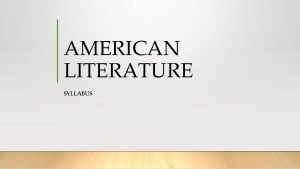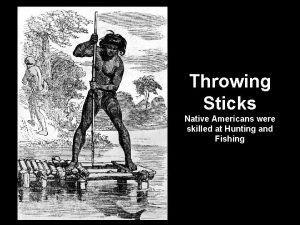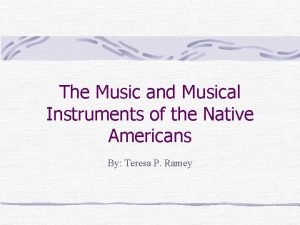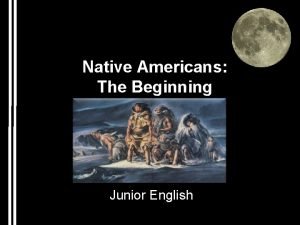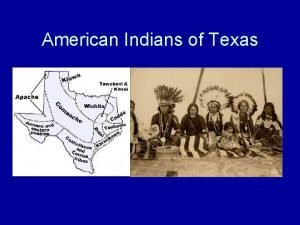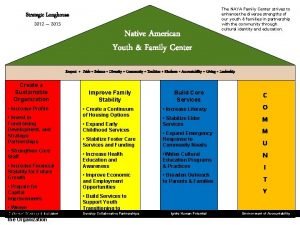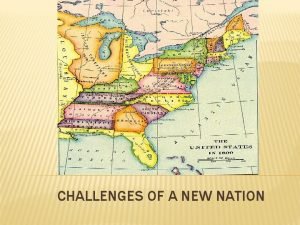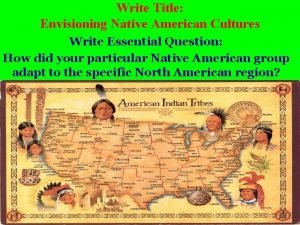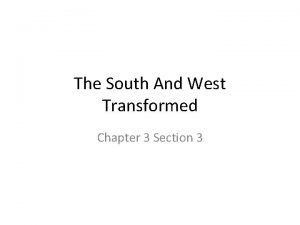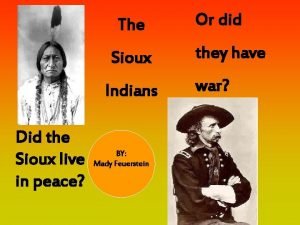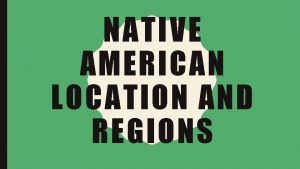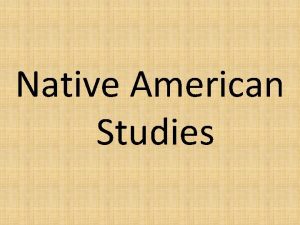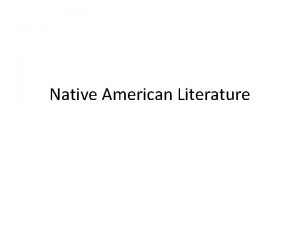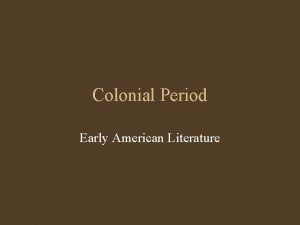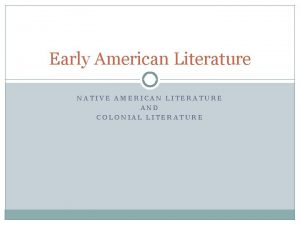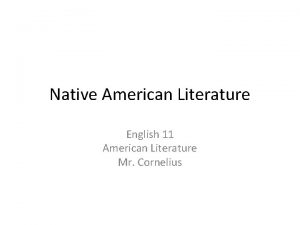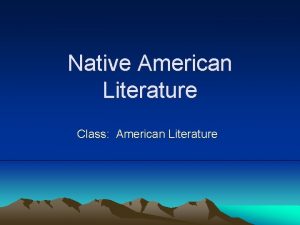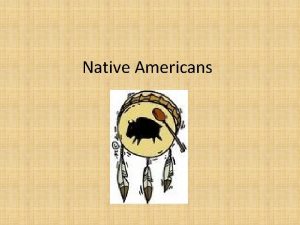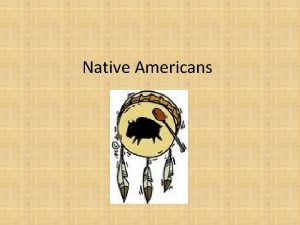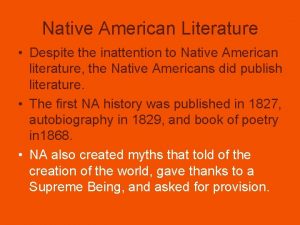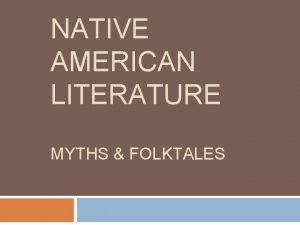Native American Literature Native American Literature The most

















- Slides: 17

Native American Literature

Native American Literature The most striking fact about N. A. literature is the cultural diversity that it represents. At the time of Columbus – 350 distinct languages existed in the U. S. Given all of the various tribes, cultures, languages that existed and still do exist, we cannot define a single Native American culture or literature due to its complexity. so Thousands of distinct cultural groups existed as well.

History of Stability • Prospered for thousands of years in a stable relationship with the land • Hundreds of individual tribes with their own cultural traditions (in fact , they were far more diverse than those of Europe at the time), but joined together, in a sense, because they felt they had more in common with each other than with the settlers.

Native Americans have come to be isolated both geographically and culturally. (Ghetto-ized) Geographically through reservations on some of the most remote and least productive land in the country. So They have very few opportunities to demonstrate the various and unique cultural aspects of their culture.

If this is true, how did Native American Literature become known? 1856 – First widely known written Native American literature by John Rollin Ridge, who was Cherokee and encompassed the Far West in his writing. In the late 19 th century many anthropologists began to write down stories and languages they were hearing while they were examining Native American culture. Because of this, many stories are now available to read and appreciate.

Native American Literature was not considered “valid” literature before this time due to our western notion of what literature is. In the early American colony, the skirmishes. between Native Americans and Europeans were most often described by Europeans and judged by European sensibilities. Thus the literary value of Native American stories and culture was not valued because it was not what the settlers recognized as “good”. If it wasn’t a book, it wasn’t literature. It wasn’t until the 1960 s-70 s that Native American literature was given a place in our literary canon.

So what are the characteristics of Native American Literature while still remembering it is difficult to generalize the diverse cultures the term embraces? First and foremost, traditional N. A. literature has an oral history. Being a good speaker was valued in many tribes because of the tradition many tribes had of participatory democracy. Stories were handed down through the oral tradition. This is how cultures kept their stories alive.

Lost in Translation • European invasion brought linguistic tools for written records; however, much of the meaning of stories, poems, chants was lost in translation: – Literally no English words for the native terms – Especially poetry was so dependant on rhythm and repetition of sound that the translated poems are completely new – The uninitiated Caucasians rarely were given full tales and/or they may have shaped their translations to fit their audiences’ prejudices

Characteristics of Native American Literature Repetition is a common characteristic Ritual beginnings and endings Use of archaic language Oral Tradition Story telling was the primary means of communicating and teaching about the physical world, social order, appropriate behavior, and human nature, and the problem of good vs. evil. Terse writing style

http: //www. youtube. com/watch? v=VAWYRa 8 d 2 Eo

Characteristics of Native American Myths *Explains beliefs about the nature of the physical world. Example – how did the world come to be? Or, how did the sun come to be? *Takes place in primal world or pre-civilization. *Beings are animal spirits in more or less human form: monsters, confusions of nature, etc. *Mythic age flows into age of transformation (legends).

Characteristics of Legends *Culture hero orders the world. *Culture hero turns animal people into animals. *Other beings become landmarks *Flows into historical time (which are “real” heroes)

Cultural Heroes Trickster and creation mythology *They dramatize prototypical events and behaviors. *Show to do what is right and how we become the people we are. *Shape the world and gives it its character by theft of sun, fire, or water. *Often of divine birth. *Myths are not concerned with original owners, only with culture hero’s acquisition of them. Trickster heroes provide for disorder and change, enable us to see the seamy underside of life, remind us that culture is finally artificial, provide for possibility for change and redemption, may get their comeuppance!

Themes in native American mythology ~Formation of the world through struggle. ~Movements from a sky world to a water world by means of a fall. ~Fortunate fall; creation story ~Earth-diver myth: *flood that occurred after the creation of the universe. *creation of the present world out of mud brought up from the water by the earth-diver (muskrat or turtle). under ~Theft of fire ~Emergence myths: ascent of beings from under the surface of the earth to its surface and ascent from a series of underworlds.

Today • Today, many writers of Native American ancestry work to preserve their heritage, correct misunderstandings, and represent common native struggles. • Some recurrent elements to look for: connection with nature and a higher, almost pantheistic, power; representations of cultural values and traditions; responses to sudden changes with European invasion.

A few Native American authors Louise Erdrich is likely the most well-known Native American author. She is from Minnesota and has a Native American bookstore on Loring Park. N. Scott Momaday – Contemporary Native American author. The House Made of Dawn is an American classic. Sherman Alexie – Much of his writing stems from his experience as a Native American Paula Gunn Allen is a contemporary Native American author who also writes through a Feminist lens.

Sources: Campbell. Early Native American Literature: Brief Outline Guide. 8/30/06.
 Native american literature before 1600
Native american literature before 1600 Native american writing
Native american writing Southern literature syllabus
Southern literature syllabus Native american throwing stick
Native american throwing stick Native american musical instruments
Native american musical instruments First people in the world
First people in the world Native american religious beliefs
Native american religious beliefs Medicine wheel color meanings
Medicine wheel color meanings Native american dwellings
Native american dwellings Dry cow candy bar
Dry cow candy bar Native american youth and family center
Native american youth and family center Native american connections housing
Native american connections housing Native american important facts
Native american important facts Native american tribes
Native american tribes What three circumstances hurt native americans
What three circumstances hurt native americans Where sioux lived
Where sioux lived Indian skywalkers
Indian skywalkers Native american tribes in the united states
Native american tribes in the united states


